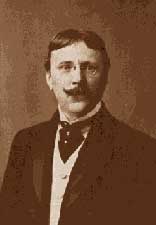 The Buster Brown Series was a set of kinetoscope films from 1904 based Richard Felton Outcault's comic strip characters, Buster Brown was a kind of Little Lord Fauntleroy figure with long blond hair & bangs & dressed rather girlishly by his mom.
The Buster Brown Series was a set of kinetoscope films from 1904 based Richard Felton Outcault's comic strip characters, Buster Brown was a kind of Little Lord Fauntleroy figure with long blond hair & bangs & dressed rather girlishly by his mom.
But at heart he was no sissy. Boy funny-page characters had by & large been working class or poor, including Outcault's first popular cartoon character The Yellow Kid, but Buster was upper crust, hence the sissy outfit.
Unfortunately for some kids, there was a Buster Brown line of boys clothing including Buster's get-up. Pity the boys of Podunk, USA, whose insane mothers sent them to school in shortpants, ribbons, & a girl's hat.
Buster & his rambunctious dog Tige caused all sorts of troubles just like the streetwise kids. Unlike working class comics kids, who were frequently spanked for their misdeeds, Buster only on the rarest occasion got punished. Generally his mother invariably thought him such a good boy no matter what he'd done.
The character debuted in 1902 in the New York Herald & was extremely popular. In 1904, Buster & Tige became the symbol of Buster Brown Shoes, thanks to a coincidence of name. The children's shoe brand, founded in 1878, still exists.
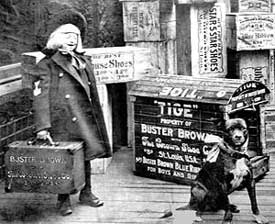 Midget circus performer Major Ray played Buster Brown at the 1904 World's Fair in St. Louis. Midget circus performer Major Ray played Buster Brown at the 1904 World's Fair in St. Louis.
Soon a whole army of midget actors, together with trained Tiges, were hired by the Brown Shoe Company to visit department stores & shoe retailers nationwide & do skits in department stores. Curiously, Buster would not appear in print ads until 1911.
The strip was discontinued in 1921, but there followed silent films with child star Arthur Trimble to keep Buster in the public conscience a little while longer.
Long after the strip was no longer in the papers, the image of Buster & Tige could still be seen on the labels inside the shoe brand, & a slogan that went "I'm Buster Brown, & I live in a shoe. That's my dog, Tige, & he lives there, too."
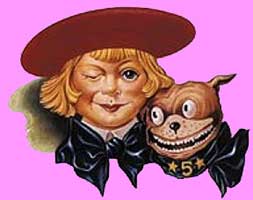 Buster advertised the shoes in early television ads, too, even though kids of that generation had no idea who he was, why he wore such a girly hat, or why the dog had such a creepy grin. Many a child feared their shoes thanks to that grin. Buster advertised the shoes in early television ads, too, even though kids of that generation had no idea who he was, why he wore such a girly hat, or why the dog had such a creepy grin. Many a child feared their shoes thanks to that grin.
Outcault had previously worked for Thomas Edison as a technical illustrator, & was by a lovely coincidence a nephew of Edwin S. Porter. He was so thrilled to participate in the film he agreed to make a guest appearance in the film itself.
But he was soon reminded by threat of suit that he had sold the theatrical rights, & a musical was that very year being launched. The producers felt theatrical rights included kinetoscope, & Outcault ceased being involved with the Edwin Porter production, & even attempted to stop its distribution.
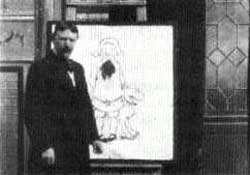 Before bowing out of the films, Outcault had finished a "personal appearance" in R. F. Outcault Making a Sketch of Buster & Tige intended to be shown with the set. This is lacking in the Library of Congress copy. Before bowing out of the films, Outcault had finished a "personal appearance" in R. F. Outcault Making a Sketch of Buster & Tige intended to be shown with the set. This is lacking in the Library of Congress copy.
The separately released Buster's Joke on Papa is likewise lacking. That leaves five intact "chapters" each of which stands as a separate film complete in itself. Unlike The Great Train Robbery (1903), it is not really a "feature" film if quarter-hour films may be so likened.
They were instead a collection of short-shorts. The chapters are unnumbered & were not necessarily shown in a particular order. The Edison company preferred selling them as a set, to be viewed one segment at a time in a row of kinetoscopes. But they were also available as separate shorts.
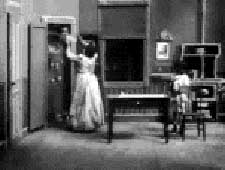 In Porter's adaptation to kinetoscope films, he left out Buster's sister Mary Jane, but retained the housekeeper Bridget & of course Buster's adoring mother Mrs. Brown. In Porter's adaptation to kinetoscope films, he left out Buster's sister Mary Jane, but retained the housekeeper Bridget & of course Buster's adoring mother Mrs. Brown.
In the comic strip, the dog Tige could talk when adults weren't around, a la Calvin & Hobbs, but kinetoscopic films being silent immediately did away with this attribute of Tige.
The scripts were nevertheless surprisingly true to the original, though not all episodes filmed were based on specific comic strips.
Porter was assisted on the scripts by Gilbert M. 'Broncho Billy' Anderson. In seven chapters plus an "extra" eighth chapter released as a separate film, this was the first long film released after Porter's runaway success The Great Train Robbery.
In Buster's Dog to the Rescure, the cook Bridget puts a box of cookies on a high shelf. As soon as she's out of the room, Buster gets out the step-ladder.
His mom catches him & gives him one of his rare spankings, half-hearted & softly done. When mom leaves the room, Tige the dog hurries in, runs up the ladder, grabs the box, & brings it to Buster. They share the content.
Tige was played by Mannie, the same dog from Laura Comstock's Bag-punching Dog (1901). Mannie became famous on the Vaudeville circuit then became the world's first movie star dog appearing in the Happy Hooligan films & in Pie, Tramp, & the Bulldog (1901), The Whole Dam Family & the Dam Dog (1905), & The Terrible Kids (1906).
And at the end of Dog Factory (1904), Porter's first film after the Buster Brown series, Mannie shows up at the very end as the attack-dog who knocks down the tough guy. It's much the biggest role of any of the many dogs at the factory. And I presume the lady with the bulldog pups is Laura Comstock, making sure the group of dogs are obedient for the take. Laura's husband/manager Norman H. Mosher was friends with Porter, as well as Mannie's co-trainer.
At the time of the filming of Buster's Dog to the Rescue it wasn't yet planned to make it a series. It was, in fact, intended as a vehicle for Mannie the dog, & it only slowly dawned on everyone to make the kid Buster Brown, & the rest of the series just flowed thereafter.
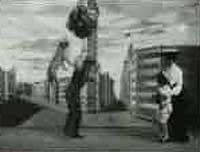 Buster & Tige Put a Baloon Vendor Out of Business (the film's title card itself misspelling Balloon) is set on a stage with a backdrop painting of New York's corner of the Flat-iron building.
Buster & Tige Put a Baloon Vendor Out of Business (the film's title card itself misspelling Balloon) is set on a stage with a backdrop painting of New York's corner of the Flat-iron building.
A balloon vendor saunters center stage & gazes straight out at the camera. Buster Brown & his mother happen by & Buster begs for a balloon. His mom pretty much always gives him what he wants, but before Buster can get one, Tige assisted by two other dogs begin to harrass the vendor until all the balloons are unleashed.
The dogs to keep leaping at with their muzzles, adapting pretty much the same stunt Mannie performed in Laura Comstock's Bag-punching Dog.
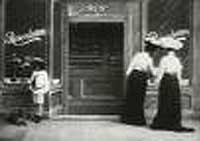 As Buster & the Dude begins, Buster's mother & her friend are gazing in the window of Rosenbaum's hatshop. Buster & Tige dally nearby, bored.
As Buster & the Dude begins, Buster's mother & her friend are gazing in the window of Rosenbaum's hatshop. Buster & Tige dally nearby, bored.
A well-dressed dandy is walking his little dog, the dog tricked out in ribbons. The dude begins to chat up the ladies, & they respond amiably, petting his dog.
Buster intrudes as if to inform his mom & her friend that Tige would also like some attention, but they ignore him. So Buster turns Tige loose on the other dog, & Tige grabs the dude's dog by the ribbons & spins him around.
The dude is so overexcited he dances around absurdly then tries to kick Tige, which displeases Buster's doting mom who knocks the hat off the dude's head. Tige lets go of the rival dog's ribbons & grabs the hat, which both dogs fight over in a game of tug of war.
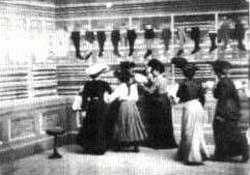 Buster Makes Room for Momma at the Bargain Counter is a fine example of Mrs. Brown's exceeding tolerance of Tige & her son's misbehaviors, & proof that spoiling kids instead of terrorizing them into obedience did not begin with Dr. Spock. This one's also based on a specific Sunday comic strip. Buster Makes Room for Momma at the Bargain Counter is a fine example of Mrs. Brown's exceeding tolerance of Tige & her son's misbehaviors, & proof that spoiling kids instead of terrorizing them into obedience did not begin with Dr. Spock. This one's also based on a specific Sunday comic strip.
Inside the fabric store, women have formed a great mass of shopping chaos around the bargain table. Buster's mom arrives late & ends up in a fight over a piece of fabric, which she loses, & gives up even trying to get to the table.
At Buster's command, Tige begins doing backflips & presumedly barking up a storm, annoying the cluster of ladies who in consequence go to another part of the store. in the Sunday comic strip which is not restricted to pantomime, it's made clear that the women who refused to make room for Mrs. Brown became convinced Tige was rabid.
Buster's mom can now sort through the bargain fabrics at her liesure, while Tige ceases to entertain himself chewing up a footstool, & climbs onto the stool to sit quietly like a good dog. Mom gives Buster a kiss for being such a useful hellion.
Buster's Revenge on the Tramp shows Bridget is sitting in the kitchen, seated next to the table, sound asleep. Buster demands a snack, but Bridget won't wake up to make him anything. So he sneaks up on her & ties her apron up over her head.
Even with aid of a footstool Buster's too short to reach the jam on the top of the pantry shelf. A tramp looks in at the window, identified in the Edison catalog as Weary Willie who appears in the Porter-directed "the tramp" series, including Weary Willie and the Gardener, The Tramps Dream, The Tramp's Miraculous Escape, Pie Tramp & Bulldog & The Tramp & the Nursing Bottle (all 1901), each based on Vaudeville gags.
Beginning in 1896 ther was an entirely different comic strip in England called Weary Willie & Tired Tom by Tom Browne, but the name had already been used in Vaudeville as a universal designation for many an unfortunate tramp character, & continued to occur in silent films on both sides of the Atlantic from at least 1897 through the 1920s.
"Weary Willie" also designated any sad tramp type clown in the circus, & would eventually become the name of the world-famous sorrowful clown played by Emmett Kelly, Sr (1898-1979), although that name was in time displaced by the public's preference for calling him Kelly the Clown. Kelly would allege even in court that he created Weary Willie himself, but there were Weary Willies in circus rings when Kelly was a small boy.
Buster Brown solicits Weary Willy's help. The Tramp climbs in the window & gets the jam from the top shelf, sits at the table to eat, but refuses to share any with Buster.
Buster fetches his mom who wakes up Bridget who falls from the chair. She leaps up untangling herself from her apron & beats Willie with a broom until he leaps out the window & flees.
Mom, pampering Buster for his close call with the awful man, gives her son all the jam he wants while Bridget makes like she's busy sweeping the floor.
copyright © by Paghat the Ratgirl
|
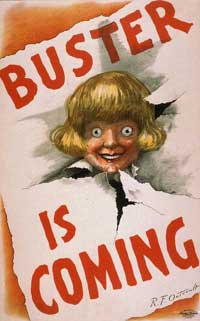

 Midget circus performer Major Ray played Buster Brown at the 1904 World's Fair in St. Louis.
Midget circus performer Major Ray played Buster Brown at the 1904 World's Fair in St. Louis. Buster advertised the shoes in early television ads, too, even though kids of that generation had no idea who he was, why he wore such a girly hat, or why the dog had such a creepy grin. Many a child feared their shoes thanks to that grin.
Buster advertised the shoes in early television ads, too, even though kids of that generation had no idea who he was, why he wore such a girly hat, or why the dog had such a creepy grin. Many a child feared their shoes thanks to that grin. Before bowing out of the films, Outcault had finished a "personal appearance" in R. F. Outcault Making a Sketch of Buster & Tige intended to be shown with the set. This is lacking in the Library of Congress copy.
Before bowing out of the films, Outcault had finished a "personal appearance" in R. F. Outcault Making a Sketch of Buster & Tige intended to be shown with the set. This is lacking in the Library of Congress copy.


